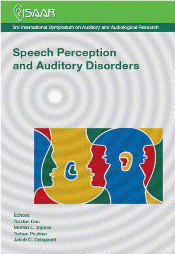Predicting speech intelligibility in adverse conditions: evaluation of the speech-based envelope power spectrum model
Abstract
The speech-based envelope power spectrum model (sEPSM) [Jørgensen and Dau (2011). J. Acoust. Soc. Am., 130 (3), 1475–1487] estimates the envelope signal-to-noise ratio (SNRenv) of distorted speech and accurately describes the speech recognition thresholds (SRT) for normal-hearing listeners in conditions with additive noise, reverberation, and nonlinear processing by spectral subtraction. The latter represents a condition where the standardized speech intelligibility index and speech transmission index fail. However, the sEPSM is limited to stationary interferers due to the fact that predictions are based on the long-term SNRenv. As an attempt to extent the model to deal with fluctuating interferers, a short-time version of the sEPSM is presented. The SNRenv of a speech sample is estimated from a combination of SNRenv-values calculated in short time frames. The model is evaluated in adverse conditions by comparing predictions to measured data from [Kjems et al. (2009). J. Acoust. Soc. Am. 126 (3), 1415-1426] where speech is mixed with four different interferers, including speech-shaped noise, bottle noise, car noise, and cafe noise. The model accounts well for the differences in intelligibility observed for the different interferers. None of the standardized models successfully describe these data.
References
Christiansen C., Pedersen, M. S., Dau,T. (2010). “Prediction of speech intelligibility based on an auditory preprocessing model” Speech. Commun., 52, 678–692.
Dubbelboer, F., and Houtgast, T. (2007). “A detailed study on the effects of noise on speech intelligibility” J. Acoust. Soc. Am. 122, 2865-2871.
Dubbelboer, F., and Houtgast, T. (2008). “The concept of signal-to-noise ratio in the modulation domain and speech intelligibility” J. Acoust. Soc. Am. 124, 3937-3946.
Duquesnoy, A. J., and Plomp, R. (1980). “Effect of reverberation and noise on the intelligibility of sentences in cases of presbyacusis” J. Acoust. Soc. Am. 68, 537-544.
Festen, J. M., and Plomp, R. (2011). “Effects of fluctuating noise and interfering speech on the speech reception threshold for impaired and normal hearing” J. Acoust. Soc. Am., 88 (4), 1725–1736.
Green, D. M. and Swets, J. A. (1988). Signal Detection Theory and Psychophysics (Peninsula Publishing, Los Altos California), 238-239.
Jørgensen, S. and Dau, T. (2011). “Predicting speech intelligibility based on the signal-to-noise envelope power ratio after modulation-frequency selective processing” J. Acoust. Soc. Am., 130 (3), 1475–1487.
Kjems, U., Boldt, J. B., Pedersen, M. S., Lunner, T., and Wang, D., (2009), “Role of mask pattern in intelligibility of ideal binary-masked noisy speech” J. Acoust. Soc. Am. 126 (3), 1415–1426.
Kryter, K. D., (1962), “Validation of the Articulation Index” J. Acoust. Soc. Am. 34(11), 1698–1702.
Ludvigsen, C., Elberling, C., and Keidser, G. (1993). “Evaluation of a noise reduction method-comparison between observed scores and scores predicted from STI” Scand. Audiol. Suppl. 38 22, 50-55.
Nielsen, J. B. and Dau, T. (2009). “Development of a Danish speech intelligibility test” Int. J. Audiol. 48, 729-741.
Additional Files
Published
How to Cite
Issue
Section
License
Authors who publish with this journal agree to the following terms:
a. Authors retain copyright* and grant the journal right of first publication with the work simultaneously licensed under a Creative Commons Attribution License that allows others to share the work with an acknowledgement of the work's authorship and initial publication in this journal.
b. Authors are able to enter into separate, additional contractual arrangements for the non-exclusive distribution of the journal's published version of the work (e.g., post it to an institutional repository or publish it in a book), with an acknowledgement of its initial publication in this journal.
c. Authors are permitted and encouraged to post their work online (e.g., in institutional repositories or on their website) prior to and during the submission process, as it can lead to productive exchanges, as well as earlier and greater citation of published work (See The Effect of Open Access).
*From the 2017 issue onward. The Danavox Jubilee Foundation owns the copyright of all articles published in the 1969-2015 issues. However, authors are still allowed to share the work with an acknowledgement of the work's authorship and initial publication in this journal.


